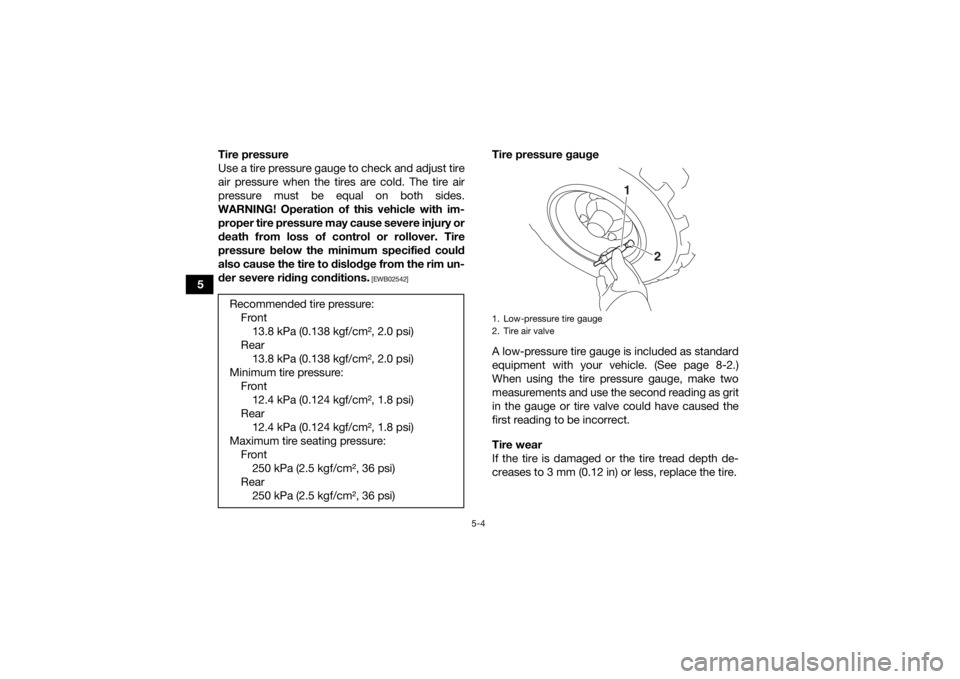Page 50 of 132
5-2
5
Throttle lever• Make sure that operation is smooth. Lubricate cable and lever
housing if necessary.
• Check lever free play, and adjust if necessary. 5-3, 8-21
Control cables • Make sure that operation is smooth. Lubricate if necessary. 8-29
Drive chain • Check chain slack, and adjust if necessary.
• Check chain condition. Lubricate if necessary. 5-3, 8-26, 8-28
Wheels and tires • Check wheel condition, and replace if damaged.
• Check tire condition and tread depth. Replace if necessary.
• Check air pressure. Correct if necessary. 5-3
Brake levers • Make sure that operation is smooth. Lubricate lever pivoting points
if necessary. 8-29
Chassis fasteners • Make sure that all nuts, bolts and screws are properly tightened. 5-6
Instruments and switches • Check operation, and correct if necessary. 5-6
ITEM ROUTINE PAGEUBW461E0.book Page 2 Tuesda
y, January 31, 2017 5:13 PM
Page 52 of 132

5-4
5Tire pressure
Use a tire pressure gauge to check and adjust tire
air pressure when the tires are cold. The tire air
pressure must be equal on both sides.
WARNING! Operation of this vehicle with im- proper tire pressure may cause severe injury or
death from loss of control or rollover. Tire
pressure below the minimum specified could
also cause the tire to dislodge from the rim un-
der severe riding conditions.
[EWB02542]
Tire pressure gauge
A low-pressure tire gauge is included as standard
equipment with your vehicle. (See page 8-2.)
When using the tire pressure gauge, make two
measurements and use the second reading as grit
in the gauge or tire valve could have caused the
first reading to be incorrect.
Tire wear
If the tire is damaged or the tire tread depth de-
creases to 3 mm (0.12 in) or less, replace the tire.
Recommended tire pressure:
Front13.8 kPa (0.138 kgf/cm², 2.0 psi)
Rear 13.8 kPa (0.138 kgf/cm², 2.0 psi)
Minimum tire pressure: Front12.4 kPa (0.124 kgf/cm², 1.8 psi)
Rear 12.4 kPa (0.124 kgf/cm², 1.8 psi)
Maximum tire seating pressure: Front250 kPa (2.5 kgf/cm², 36 psi)
Rear 250 kPa (2.5 kgf/cm², 36 psi)1. Low-pressure tire gauge
2. Tire air valve
1
2
UBW461E0.book Page 4 Tuesda y, January 31, 2017 5:13 PM
Page 79 of 132
7-19
7
The ATV can be used to cross slow moving, shal-
low water of up to a maximum of 11 cm (4 in) in
depth. Before entering the water, choose your
path carefully. Enter where there is no sharp drop
off, and avoid rocks or other obstacles which may
be slippery or upset the ATV. Drive slowly and
carefully.
Test your brakes after leaving the water. If neces-
sary, apply them several times to let friction dry
out the linings. Do not continue to ride your ATV
without verifying that you have regained proper braking ability.
WARNING! Wet brakes may have
reduced stopping ability, which could cause
loss of control.
[EWB02622]
After riding your ATV in water, be sure to drain the
trapped water by removing the check hose at the
bottom of the air filter case. NOTICE: Undrained
water can cause damage or improper opera-
tion.
[ECB00842]
Wash the ATV in fresh water if it has been operat-
ed in salt water or muddy conditions.
UBW461E0.book Page 19 Tuesday, January 31, 2017 5:13 PM
Page 86 of 132
8-4
8
6*Exhaust system • Check for leakage and replace gasket(s) if neces-
sary.
• Check for looseness and tighten all screw clamps and joints if necessary. √√√
7 Spark arrester • Clean. √√√
8 *Air induction sys-
tem • Check the air cut-off valve, reed valve, and hose
for damage.
• Check condition and clean or replace if neces- sary. √√√
NO. ITEM
CHECK OR MAINTENANCE
JOB INITIAL EVERY
Whichev-
er comes first month136612
km (mi) 240
(150) 1300
(800) 2500
(1600) 2500
(1600) 5000
(3200)
hours 20 80 160 160 320UBW461E0.book Page 4 Tuesda y, January 31, 2017 5:13 PM